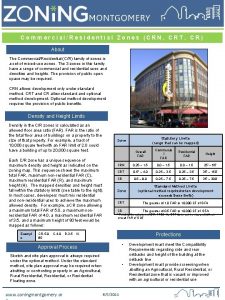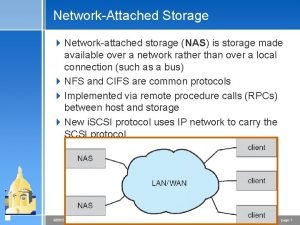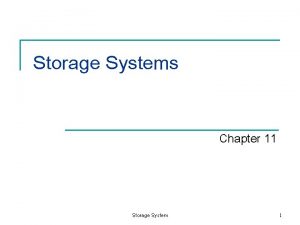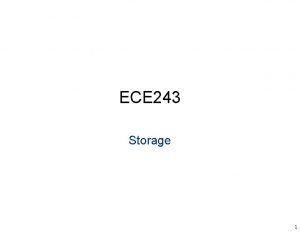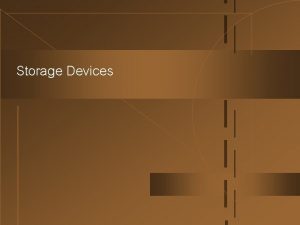Assessing the Economics of CommercialResidential Storage Using an






![Model Inputs and Assumptions to the Model Tesla Powerwall 2 Specifications [5] Roundtrip Efficiency Model Inputs and Assumptions to the Model Tesla Powerwall 2 Specifications [5] Roundtrip Efficiency](https://slidetodoc.com/presentation_image/6942e438d901dd35cbc086cc18bf065e/image-7.jpg)








- Slides: 15

Assessing the Economics of Commercial/Residential Storage Using an Intertemporal Decision Framework Himanshu Deshpande, Guannan He, Jay Whitacre Carnegie Mellon University 1

Overview • Electrochemical Energy Storage(EES) plays an important role in grid scale and residential storage. • Revenues can be generated by cycling EES such that EES is charged when electricity price is low and discharged when it is high. • The price difference between which EES is supposed to be cycled is crucial in determining the amount of revenue that is generated. Grid Selling Buying Residential/Grid scale storage $$$ 2

Terms that we will be using MBU Marginal Benefit of Use is defined as the maximum benefit that can be achieved with an incremental unit of battery usage/degradation (in $/k. Wh). DMBU Discounted Marginal Benefit of Usage is MBU adjusted by discount factor LBU Life-cycle Benefit of Use is revenue generated over the lifetime by cycling of EES. Degradation Two types of losses due to degradation in an EES are - Degradation due to cycling of EES Losses - Calendar Degradation 3

Background and Previous Research Levelized Cost Of Degradation (LCOD) Method LBU = Initial Capital Investment Revenue generated that should be generated in each cycle Limitations – • Does not consider the fact that the EES should not always keep waiting for the best short-term profit opportunity • Calendar degradation is thus ignored • Short term decisions are based on long term goals Intertemporal decision-making framework Advantages over LCOD – • Considers effect of calendar degradation • Finds the optimal MBU in short term which leads to maximum LBU in long term Motivation to apply this framework to residential EES Previous research on which our model is based on was done on grid scale EES and it was found that maximum LBU obtained using the intertemporal method was 4 times more than that from LCOD method. Abbreviations used – MBU - Marginal Benefit of Use DMBU - Discounted Marginal Benefit of Usage LBU - Life-cycle Benefit of Use MBU in short term 4

Intertemporal decision-making framework Abbreviations used – MBU - Marginal Benefit of Use DMBU - Discounted Marginal Benefit of Usage LBU - Life-cycle Benefit of Use LBU Updated DMBU Order in which Simulations are run Updated MBU DMBU Long Term Order in which Decisions are made Short Term MBU 5

Application of Intertemporal framework to Tesla Powerwall Two cases considered – 1. Wholesale Electricity Prices 2. Time of Use electricity Prices Intertemporal Decision. Making Framework Wholesale Electricity Prices Time of Use electricity prices 300 50 Price of electricity ($/MWh) 45 Price of electricity ($/MWh) Optimal MBU and Maximum LBU 40 35 30 25 20 15 10 280 260 240 220 200 5 0 0 1 2 3 4 5 6 7 8 9 10 11 12 13 14 15 16 17 18 19 20 21 22 23 Time of day Source – CASIO 2016 Wholesale data price [1] 0 1 2 3 4 5 6 7 8 9 10 11 12 13 14 15 16 17 18 19 20 21 22 23 Time of day Summer Winter Source – Southern California Edison – TOU-D-Prime – [2] 6
![Model Inputs and Assumptions to the Model Tesla Powerwall 2 Specifications 5 Roundtrip Efficiency Model Inputs and Assumptions to the Model Tesla Powerwall 2 Specifications [5] Roundtrip Efficiency](https://slidetodoc.com/presentation_image/6942e438d901dd35cbc086cc18bf065e/image-7.jpg)
Model Inputs and Assumptions to the Model Tesla Powerwall 2 Specifications [5] Roundtrip Efficiency 0. 9 [1] Specification of EES 5 k. W/14 k. Wh Number of cycles when EES reaches 70% of original capacity 3000 Lifetime Degradation limit 84 MWh Market Price $7, 250 Calendar Degradation Discount Rate 3. 5 k. Wh (0. 5% capacity loss per year [3]) 7 % [4] References – 1. 2. 3. 4. 5. Akhil, A. A. et al. DOE/EPRI 2013 Electricity Storage Handbook in Collaboration with NRECA (Sandia National Laboratories, 2013) Ecker, M. et al. Calendar and cycle life study of Li(Ni. Mn. Co)O 2 -based 18650 lithium-ion batteries. J. Power Sources 248, 839– 851 (2014). Grolleau, S. et al. Calendar aging of commercial graphite/Li. Fe. PO 4 cell—predicting capacity fade under time dependent storage conditions. J. Power Sources 255, 450– 458 (2014). He, G. , Chen, Q. , Kang, C. , Xia, Q. & Poolla, K. Cooperation of wind power and battery storage to provide frequency regulation in power markets. IEEE Trans. Power Syst. 32, 3559– 3568 (2017). https: //www. tesla. com/powerwall 7

Results Lifetime Benefit of Use per MWh cycled ($/MWh) 12 10 8 6 At an optimal MBU of 5 $ MWhthroughput– 1 every MWh of EES cycled generates a revenue of $9. 72 4 2 0 0 1 2 3 4 5 6 7 8 9 Marginal Benefit of Use ($ MWh-throughput– 1) 10 11 Maximum Lifetime revenue generated = $821 Maximum Lifetime revenue generated with LCOD method = $189 12 Lifetime Benefit of Use per MWh cycled ($/MWh) Normalized Lifetime Benefit of Use when Powerwall is cycled on Time of Use Electricity Prices Normalized Lifetime Benefit of Use when Powerwall is cycled on Wholesale Electricity Prices 80 78 76 74 At an optimal MBU of 37 $ MWhthroughput– 1 every MWh of EES cycled generates a revenue of $78. 67 72 70 68 66 0 10 20 30 40 50 Marginal Benefit of use ($ MWh-throughput– 1) 60 70 Maximum Lifetime revenue generated = $6, 608 Maximum Lifetime revenue generated with LCOD method = $5, 587 8

Interpretation Time of Use electricity prices Reason for a flat profile in Time of Use case until it reaches maximum – Reason for a larger revenue in Time of Use case – • Larger price difference • Deeper cycles of EES Price of electricity ($/MWh) • Even if MBU is lowered, the number of potential opportunities to cycle over the long term reduces by a small percentage, hence there is no apparent change in the LBU 300 280 260 240 220 200 0 1 2 Summer 3 4 5 Charging 6 7 8 9 10 11 12 13 14 15 16 17 18 19 20 21 22 23 Time of day Discharging at optimum MBU Discharging at lower MBU 9

Summary • Gaining revenue by cycling Tesla Powerwall by taking advantage of energy arbitrage is not profitable over the lifetime for both wholesale energy prices and Time of use electricity price cases • Intertemporal method is better than Levelized Cost of Degradation method for both cases • For time of use case, revenue generated is almost an order of magnitude better than wholesale electricity price case. 10

Future Work • Analyzing a scenario in which Tesla Powerwall is combined with rooftop solar/other renewable source • Another case in which electricity prices depend on peak demand Acknowledgements • This work was partially supported by the US Department of Energy (under Grant DEEE 0007165) • Carnegie Mellon University’s Wilton E. Scott Institute for Energy Innovation. 11

Thank You! 12

Backup Slides • LCOD Method DCt – Degradation cost at time t dt – EES degradation during time t CAPEX – Initial capital cost of the EES (US$) δt - Discounting factor for time t. 13

Intertemporal DCt – Degradation cost at time t dt – EES degradation during time t CAPEX – Initial capital cost of the EES (US$) δt - Discounting factor for time t λ – Price at that time interval Δh LBU Updated DMBU Updated MBU DMBU 14

Yearly revenue generation Yearly Benefit at µ=$37 MWh-throughput– 1 Yearly Benefit at µ=$5 MWh-throughput-1 1200 160 140 1000 Annual Revenue ($) 120 100 80 60 800 600 40 20 0 0 1 2 3 Year 4 5 6 7 15
 Primary storage and secondary storage
Primary storage and secondary storage Secondary storage vs primary storage
Secondary storage vs primary storage Secondary storage provides temporary or volatile storage
Secondary storage provides temporary or volatile storage Object based and unified storage
Object based and unified storage School of business and economics maastricht
School of business and economics maastricht What is mathematical economics
What is mathematical economics Btec sport unit 3
Btec sport unit 3 Unit 18 assessing children's development support needs p1
Unit 18 assessing children's development support needs p1 Ways to address grammar in the writing classroom ppt
Ways to address grammar in the writing classroom ppt Assessment and reporting ppst
Assessment and reporting ppst Assessing need for hrd
Assessing need for hrd Informal and formal reading assessments
Informal and formal reading assessments Aashto manual for assessing safety hardware
Aashto manual for assessing safety hardware Cultural dynamics in assessing global markets
Cultural dynamics in assessing global markets Assessing a new venture's financial strength and viability
Assessing a new venture's financial strength and viability Assessing cardiorespiratory fitness
Assessing cardiorespiratory fitness
















